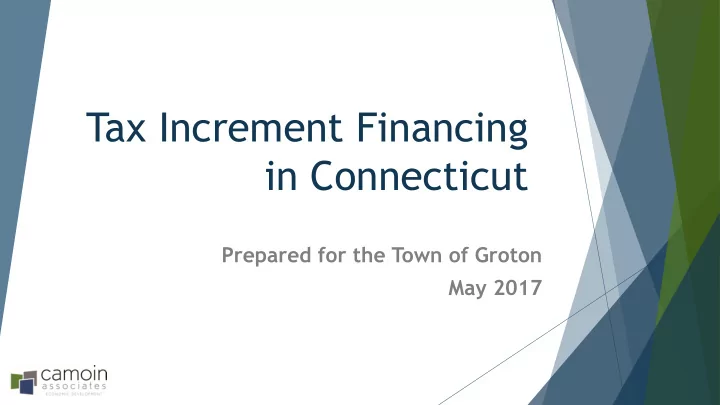

Tax Increment Financing in Connecticut Prepared for the Town of Groton May 2017
I. Overview II. Uses of TIF Revenue III. District Master Plan IV. Process V. Tips VI. Questions
What is Tax Increment Financing (TIF)? Financing method used to catalyze economic development - Allows some or all of future property tax revenues from development within a district to be dedicated to support the projects and related economic development Property tax benefits from project used to help finance project - can be utilized to support public and private development costs Portion of incremental revenues not dedicated for TIF purposes are used for general fund TIF is Not… a new tax or a special assessment on top of the existing property tax.
Overview of CT TIF Process Old TIF Process New TIF Process More Streamlined Burdensome Local Control State-level Approval TIF District Beyond Multiple Points of Approval Project Site Project Only (vs. Larger Flexible Mix of Uses District) Result Easier to Use Limited Uses Result Rarely Used
Model New Development or Private Investment (adding new valuation) % Valuation Captured in TIF District % Valuation Not Captured in TIF District Revenues to TIF Development Fund Revenues to General Fund (captured value X tax rate) (non-captured valuation X tax rate) % of Development Fund for Approved Municipal Activities - Infrastructure improvements within and outside district - Economic development organization costs, marketing & planning % of Development Fund for Approved Private Developer Costs - Land & building improvements - Tax incentives
TIF Example by the Numbers: 100% Incremental Value Captured in TIF District - $30 million in new investment Original Assessed Value (OAV): $10 million Property Taxes Paid on OAV: $219,800 ($10 million X current mill rate at 21.98 mills) Available to General Fund Value of New Development: $30 million Incremental Value above OAV: $20 million Property Taxes Paid on Incremental Value: $439,600 ($20 million X current mill rate at 21.98 mills) Used for public and or private development costs and economic development
Estimating Future Value and Revenues Valuation should be estimated based on: projected new development and redevelopment in the district, plus, overall anticipated changes in valuation due to market conditions. The mill rate can be held constant for planning purposes or have an annual escalator applied based on mill rate performance in the past five years. The mill rate will end up being the same mill rate applied to all real property – TIF is not a new or different tax!
Uses of TIF Revenue in CT Infrastructure Land Acquisition Construction, Demolition, Remodel Streetscape Capital Costs (fixtures, equipment, etc.) Professional Services (engineering, architecture, etc.) TIF Administration & Organization Costs (municipal, consulting costs) Off-Site (related to TIF District) Used to support bonds for approved TIF uses Note: Can be used to offset public and/or private developer costs and as business incentives
Other Uses Related to District Off-Site Roadways Water/Sewer Public Safety School Mitigate Adverse Impacts (e.g., new traffic) Economic Development & Environmental Economic Development Initiatives Employment Training Environmental Improvement Projects
District Master Plan Boundaries & Properties of District Improvements Length of TIF District (50 year max) Financial Plan Cost Estimates Max Debt if any Anticipated Revenue TIF Terms and Agreements Estimated Increase in Assessed Value (increment) Percent of Increment “Captured” (0 - 100%) Use of Revenues including abatements and CEA’s if any
TIF Process in CT 1. Legislative body affirms TIF will benefit the municipality 90 days prior to approval of Master Plan, submit Master Plan 2. to Planning Commission for advisory opinion 3. Hold public hearing on the proposed Master Plan Confirm eligibility criteria and assessed value requirements 4. 5. Submission of Master Plan to municipal legislative body Municipal legislative body approves Master Plan, establishes 6. tax increment district
Tips Fit use of TIFs into long-term economic development strategy Create advisory board, to advise on the planning, construction and implementation of the district Identify public and private needs Consider TIF within mix of financing options Consider going beyond use of TIFs for business incentives including to fund and public infrastructure and activities to support economic development
More Tips When using TIF revenues to benefit businesses/developers, what you provide to one will be serve as benchmark for future requests TIF policies can help direct decisions on when and how to use, can be tailored to meet community’s long term objectives Once TIFs used, implement system for tracking values, revenues, and expenditures throughout the duration Trade-off between TIF funds and General funds - What you take in for TIFs can not be used for General Fund purposes TIF Limited by State Law - The original assessed value of the tax increment district plus the original assessed value of all existing tax increment districts may not exceed ten percent (10%) of the total value of taxable real property within the municipality
TIF Terminology TIF District – property parcel(s) for which TIF plan will apply Original Assessed Value (OAV) – value of taxable real property (land & Buildings) prior to TIF District establishment Incremental Value – value from economic development - taxable development above and beyond the OAV TIF Revenues – revenues generated by incremental value within a TIF District Credit Enhancement Agreement – agreement with developer or business to return a portion of property taxes paid annually over a specified period of time to offset development costs Tax Abatement – existing CT and prior to TIF CT law allowing communities to reduce a portion of property taxes owed for specified reasons for a fixed time period of time – more restrictive than CEA’s TIF Development Plan – plan developed and approved by municipality specifying details of the district
Questions
Contact: Jim Damicis, Senior Vice President Camoin Associates Phone: (207) 831-1061 Email: jim@camoinassociates.com Web: www.camoinassociates.com Twitter: @jdamicis LinkedIn: www.linkedin.com/in/jdamicis
Recommend
More recommend